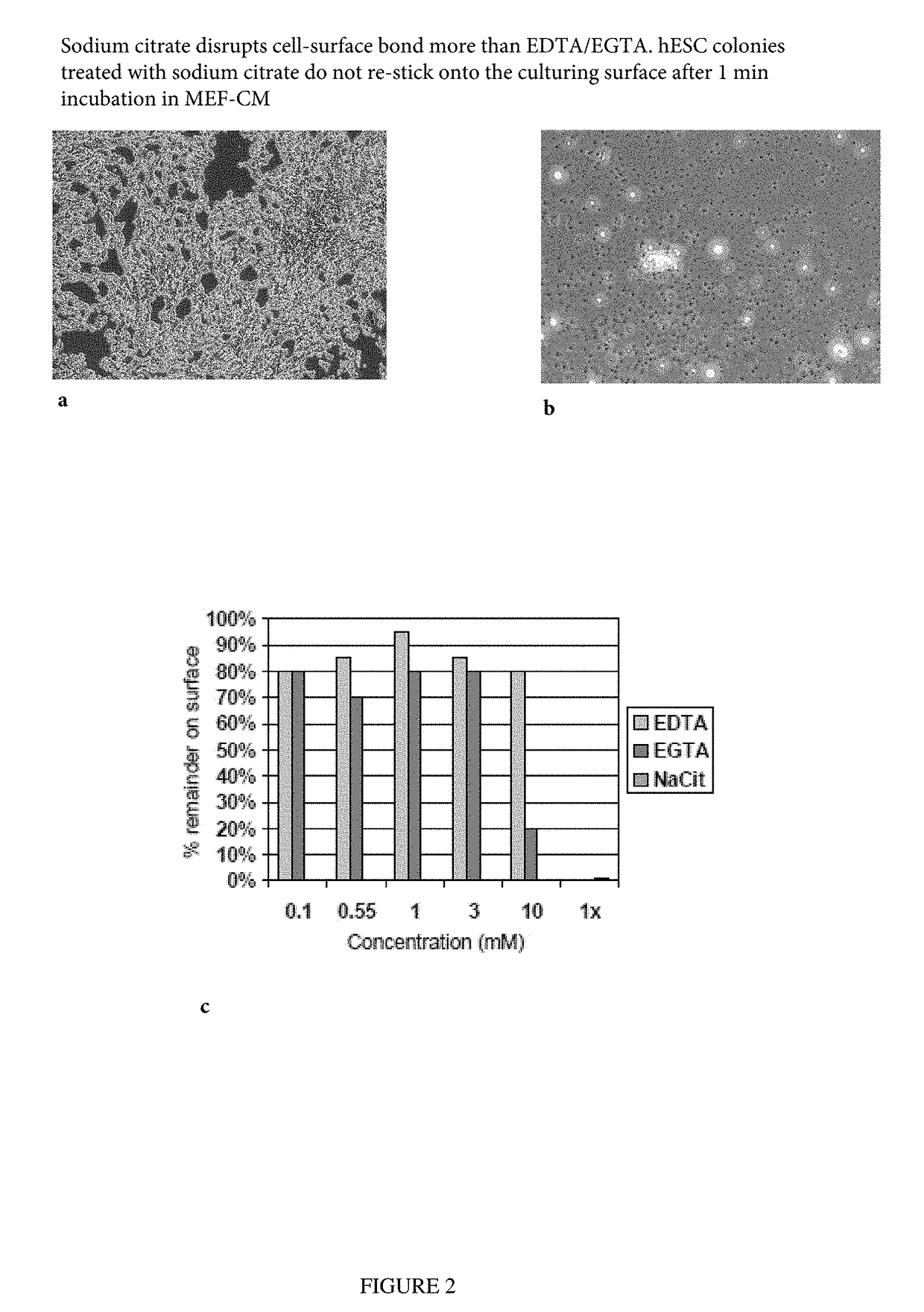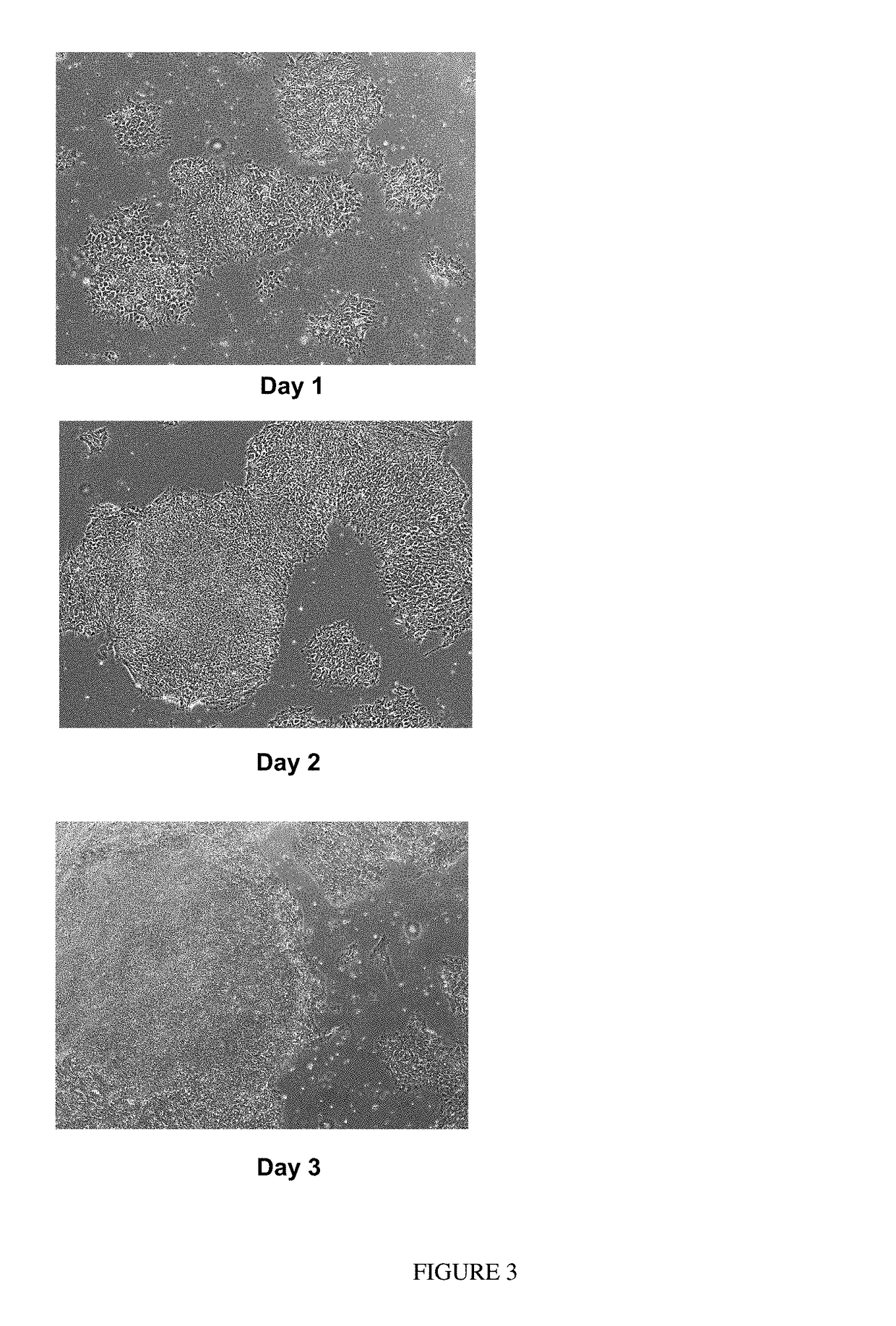Passaging and harvesting formulation and method for human pluripotent stem cells
a technology of pluripotent stem cells and formulations, applied in the field of passingaging and harvesting pluripotent stem cells, can solve the problems of limiting the scalability of hpscs production to commercially relevant lot sizes, laborious process, and inability to apply in culturing hpscs, etc., to achieve high post-detachment cell viability and high yield
- Summary
- Abstract
- Description
- Claims
- Application Information
AI Technical Summary
Benefits of technology
Problems solved by technology
Method used
Image
Examples
example 1
[0069]Preliminary Screening and Characterization of Various Non-Enzymatic Cell Detachment Formulation Solutions and Methods
[0070]Disclosed herein is a non-enzymatic reagent formulation and a method of harvesting / passaging pluripotent stem cells as clusters with high yield and high post-detachment cell viability (>90%). These cells can then be processed as final harvest or seeded into new culture vessels to be further expanded. In one embodiment, the disclosed formulation includes sodium citrate, which disrupts the cell-surface bond and cell-cell association by chelating / sequestering Ca2+, the divalent cation required for cell-surface and cell-cell binding. This sodium citrate-based formulation and process is specially designed and developed to address the unique challenges in routine or scale up hPSC culture and manufacturing processes. hPSCs are normally passaged as multi-cellular clusters / aggregates, and passaging hPSCs as single-cells is to be avoided due to low cloning efficienc...
example 2
All the Studies in Example 2 were Conducted on hESC Cultures in mTeSR1®
[0091]Determination of Optimum Sodium Citrate Formulation
[0092]Comparative Effects of Osmolarity, Potassium, and Sodium on the Ability of Sodium Citrate to Promote Cell Detachment
[0093]The 1× sodium citrate formulation described above is 15 mM sodium citrate, 135 mM KCl, pH 7.31, and 499 mOsmol / L in DPBS. Further studies were performed to determine the effects of osmolarity, KCl on the ability of the sodium citrate formulation to promote cell detachment. FIG. 12 shows the percentage of detachment of hESC in cultures treated with various solutions of sodium citrate. The results indicate that the osmolarity of the solution and the concentration of sodium citrate are important factors for achieving optimal cell detachment. In addition, at nearly normal osmolarity, the addition of potassium (KCl) to the sodium citrate formulation caused greater percentage detachment than the addition of sodium (NaCl) (compare solutio...
example 3
[0100]Time Course Studies
[0101]Versene® EDTA Versus Sodium Citrate
[0102]Studies were performed to determine the operational time windows that provide good percentage detachment and cluster size distribution. The detachments in the studies described above were evaluated after five minute treatment with cell detachment formulations. Here, treatment time is extended up to 20 minutes, and detachment and cluster size are examined under various time points (2, 5, 8, 10, 15 and 20 minutes). Formulations of moderate osmolarity and pH are selected from prior studies and the time span (operational window) of treating hESC culture with these formulations that would yield a desirable percentage detachment and post-detachment cluster size distribution is determined Cell cultures were treated with the solutions of FIG. 17 for 2, 5, 8, 10, 15 or 20 minutes and then tapped twice to dislodge the cells. For each treatment time point, cultures were evaluated for percentage detachment of cells and clus...
PUM
| Property | Measurement | Unit |
|---|---|---|
| size | aaaaa | aaaaa |
| cluster size | aaaaa | aaaaa |
| time | aaaaa | aaaaa |
Abstract
Description
Claims
Application Information
 Login to View More
Login to View More - R&D
- Intellectual Property
- Life Sciences
- Materials
- Tech Scout
- Unparalleled Data Quality
- Higher Quality Content
- 60% Fewer Hallucinations
Browse by: Latest US Patents, China's latest patents, Technical Efficacy Thesaurus, Application Domain, Technology Topic, Popular Technical Reports.
© 2025 PatSnap. All rights reserved.Legal|Privacy policy|Modern Slavery Act Transparency Statement|Sitemap|About US| Contact US: help@patsnap.com



